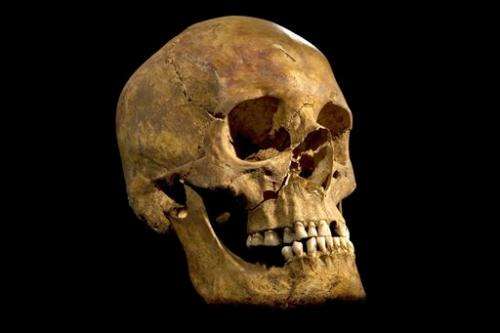Scientists to reveal result of Richard III hunt

Has Britain's lost king been found? Later Monday, scientists will announce the results of tests conducted to determine whether a battle-scarred skeleton found under a municipal parking lot in central England belongs to 15th-century King Richard III, the last English monarch to die in combat.
The University of Leicester, which is leading the search, refuses to speculate on what the announcement will say. But archaeologists, historians and local tourism officials are all hoping for confirmation that the monarch's long-lost remains have been located.
So are the king's fans in the Richard III Society, set up to re-evaluate the reputation of a reviled monarch. Richard was immortalized in a play by William Shakespeare as a hunchbacked usurper who left a trail of bodies—including those of his two young nephews, murdered in the Tower of London—on his way to the throne.
"It will be a whole new era for Richard III," the society's Lynda Pidgeon said. "It's certainly going to spark a lot more interest. Hopefully people will have a more open mind toward Richard."
Richard III remains an enigma—villain to many, hero to some. He ruled England between 1483 and 1485, during the decades-long tussle over the throne known as the Wars of the Roses. His brief reign saw liberal reforms, including introduction of the right to bail and the lifting of restrictions on books and printing presses.
His rule was challenged, and he was defeated and killed at the Battle of Bosworth Field by the army of Henry Tudor, who took the throne as King Henry VII.
For centuries, the location of Richard's body has been unknown. Records say he was buried by the Franciscan monks of Grey Friars at their church in Leicester, 100 miles (160 kilometers) north of London. The church was closed and dismantled after King Henry VIII dissolved the monasteries in 1538, and its location eventually was forgotten.
Then, last September, archaeologists searching for Richard dug up the skeleton of an adult male who appeared to have died in battle. There were signs of trauma to the skull, perhaps from a bladed instrument, and a barbed metal arrowhead was found between vertebrae of the upper back.
The remains also displayed signs of scoliosis, which is a form of spinal curvature, consistent with contemporary accounts of Richard's appearance, though not with Shakespeare's description of him as "deform'd, unfinished," hunchback.
The university has said the findings amount to "strong circumstantial evidence" that the remains are Richard's. Ahead of Monday's revelation of the results, the University of Leicester released an image of the body's skull. Archaeologist Jo Appleby said it was found "in good condition, although fragile," and had yielded detailed information about the individual.
Since the discovery, researchers have been conducting scientific tests, including radiocarbon dating to determine the skeleton's age. They also have compared its DNA with samples taken from a London cabinet-maker identified as a 17th great-grand-nephew of the king's elder sister.
Pidgeon said she hopes a new flurry of interest will help redress the "Tudor propaganda" that has stained Richard's reputation for centuries. The best-known accounts of his reign were written long after his death, during the rule of his archenemies, the Tudors.
To this day, the Tudors remain more famous and more glamorous—especially Henry VII's son, the much-married Henry VIII.
"With Henry VIII you've got six wives, sex and things going on," Pidgeon acknowledged. "It's a bit hard to compete with that when you are a bit more straight-laced, as Richard was."
Copyright 2013 The Associated Press. All rights reserved. This material may not be published, broadcast, rewritten or redistributed.




















